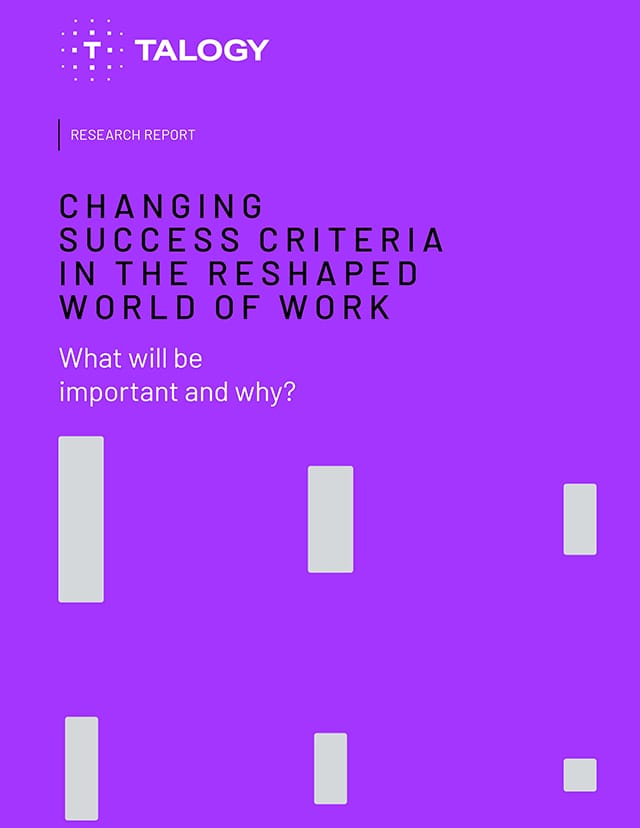Written by Vicki Bauer, Content Marketing Manager
Speaking personally, 2022 was slightly less of a blur as compared to the previous few years. Even still, I am always shocked at how quickly that turn of the calendar from one year to the next sneaks up on me. The past year was unsurprisingly full of major stories from the Russian invasion of Ukraine to the passing of Queen Elizabeth II to record inflation impacting many countries. When it comes to HR headlines, we saw a great emphasis placed on initiatives like more permanent hybrid working arrangements, employee engagement, and resilience alongside trending topics like quiet quitting and the dark traits of leadership.
I sat down with our experts to get their take on what’s on the horizon when it comes to talent management as we move into 2023. Some of their expected trends to watch for have been part of the conversation previously in some capacity but are evolving and will warrant time and resources from your organisation.
1. Provide learning and development opportunities
Lindsay K. Beers, OD Consultant, Development Solutions:
“Historically, learning & development (L&D) opportunities were viewed as nice-to-haves. Now, however, they are becoming a must-have item on employees’ checklists when shopping for new career opportunities and when deciding whether or not they want to stay at their current workplace. In fact, ‘a common reason for 40% to quit is the lack of professional growth.’ Employees benefit from L&D opportunities, as they support their professional growth, but they also appreciate knowing their employers are investing in them. After all, the average employee spends one third of their life at work, and they want to feel they are valued and getting more out of their experience than just a paycheck.
Employers should be equally interested in building out their cadre of L&D opportunities. When there are numerous L&D opportunities within reach (i.e., blended learning programmes), employee engagement is likely to increase. Additionally, employees feel empowered and motivated, and in turn, are more likely to stay with their organisations and drive stronger business results. If that isn’t compelling enough, tailored, targeted L&D solutions can help upskill employees to better promote within and help bridge any potential gaps between where employees are now with certain skills or competencies, and where they need to be.”
2. Prioritise diversity, equity, and inclusion
Susan Stang, Group Vice President, Americas Consulting:
“According to a survey we recently conducted of corporate executives and HR leaders from all around the globe, most agree that talent acquisition and retention are one of the top five challenges facing organisations in 2023 and beyond. And, given the crises, change, and challenges of the past several years, employee expectations for leaders and organisations have clearly changed.
Employees now look for and expect people-centric strategies that create a culture of inclusivity, well-being, and belonging. Purpose drives engagement, and connection, inclusion, and appreciation are key to attracting and retaining top quality employees. As a result, diversity, equity, and inclusion (DEI) will remain at the top of strategic priorities for successful organisations.
Yet prioritising DEI is not enough. In 2023 and beyond, the emphasis will need to change from one-and-done training workshops to an ongoing exploration of inclusion, from tracking numbers to identifying actionable insights, from measuring representation in applicant pools to improving the employee experience throughout, and from training leaders in avoiding bias to coaching them in how to create an environment in which all voices are heard and valued.”
3. Implement modern assessment technology
John Field, Vice President, Product Management:
“In 2023, we see international labour markets reacting in various ways due to the macro-economic factors affecting the world. Demand for some positions is increasing which in turn increases the need for employers to efficiently deal with a large volume of candidates. Demand for other positions is declining which can emphasise the importance of ensuring that employers are finding the right candidate for the job. The need to develop the skillsets of existing employees also remains strong as companies and individuals are leveraging this season for growth.
In all cases, we believe that talent professionals serve their companies and participants well when they leverage a modern assessment platform that provides for both agility and optionality. Utilising a platform that is designed to provide a great participant experience, maximise participant insights, and minimise assessment time creates an optimised candidate experience and ease of use for administrators interpreting results. Utilising this kind of technology is becoming more important and allows your organisation to react more nimbly to changing labour market dynamics with state-of-the-art assessments and technology.”
4. Renew the focus on leadership development programmes
Jon Gove, Managing R&D Consultant:
“As the winds of the economies change in many countries, we see organisations also switching their focus from bringing in the best new talent, to holding on to and growing their best leaders. Now, perhaps more than ever, it is critical that organisations make the most of their existing pool of leadership talent whether that be through blended learning, resilience coaching, or emotional intelligence enhancement.
One of the best and most proven ways to kick-start leadership development as well as initiate change management has been shown to be using a 360. Collecting objective feedback ratings on critical behaviours with supplementary rich written feedback has proven to be a staple of leadership development.
In fact, 360s are seeing a recent resurgence in popularity as leading providers like Talogy continue to evolve the offering, bringing technology developments, updated reporting capabilities and more contemporary competency models together to make the modern 360 quicker, easier, and more powerful. As uncertainty and instability have solidified themselves as part of our everyday lives, have a solid leadership development and change management plan will put you on track to weather any storm that takes aim at your organisation.”



